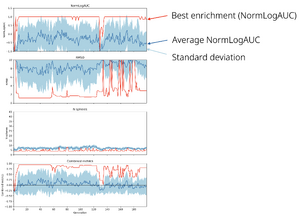Global Matching Sphere Optimization: Difference between revisions
No edit summary |
No edit summary |
||
| Line 58: | Line 58: | ||
It produces <code>combined_metrics.png</code> | It produces <code>combined_metrics.png</code> | ||
[[File:Combined metrics plot from a GA run.png|thumb|Combined metrics plot from a GA run]] | [[File:Combined metrics plot from a GA run.png|thumb|Combined metrics plot from a GA run]] | ||
* If not converged* | |||
The program will stop after 200 generations if convergence is not reached. In case it takes too long you can stop it any time by pressing Ctrl-C. It doesn't mean that you have no results, though. Juggler generates <code>combined_metrics.dat</code> file in the working directory, which contains metrics for all sets explored. It contains the following columns: | |||
Generations Set# NormLogAUC RMSD Nsph Combined_metrics | |||
You can paste its content into Excel, sort by the highest NormLogAUC and pick a MS set of your liking. | |||
Revision as of 00:00, 2 May 2023
Goal
To optimize your matching sphere (MS) setups getting more enrichment with fewer spheres.
Description
The program performs optimization of matching spheres using genetic algorithm. It selects spheres from two sets:
- heavy atoms of xtal-lig
- spheres prepared by SPHGEN program
At each generation, N matching sphere sets are created, containing a maximum of M spheres each. Then retrospective docking is done for each set, and sets are ranked by the
- enrichment (normalized logAUC, see Ian's paper),
- RMSD of the docked pose to the experimental one.
After that, a quarter of sets "survive" and produce a new generation by direct transfer, mutations, and crossover. This process is repeated until enrichment, RMSD and minimum number of spheres do not change substantially in 10 generations.
The program consists of two main modules:
- a Python script (
juggler.py) that performs MS generation, optimization, and ranking. - a Bash script, that watches created directory structure, runs docking and processes docking results
Setup & Running
So far, the program is running on Wynton. LMK if you are interested in launching it on Gimel or other clusters.
The scripts and example config file are in /wynton/home/irwin/ak87/ak87/UCSF/NEOCORTEX/SCRIPTS/RELEASE
Preparation
Prepare dockfiles directory with any tools of your liking (blastermaster, dockopt etc). You will also need rec.pdb, rec.crg.pdb, xtal-lig.pdb, ligands.names, decoys.names and a sdi directory with the paths to ligand .tgz files. To get RMSD of xtal-lig docked poses to the experimental pose, your xtal-lig.pdb must have correct bond orders and atom valences. You can edit it in Schrodinger and save as xtal-lig.pdb.
Prepare juggler_config.yml file. Put it into an empty directory.
Running
Enter a screen environment so your run is not interrupted if you disconnect your SSH session. Then do:
source /wynton/group/bks/soft/python_envs/python3.8.5.sh
python /wynton/home/irwin/ak87/ak87/UCSF/NEOCORTEX/SCRIPTS/RELEASE/juggler.py
You can detach from the screen (Ctrl-A d).
Open a new screen. In the same directory launch a docking daemon
/wynton/home/irwin/ak87/ak87/UCSF/NEOCORTEX/SCRIPTS/RELEASE/rundockd-wynton-taskid.sh
You can run other calculations on Wynton in the meantime, as Juggler will track the task IDs that it launched.
The run will take few hours to ~2 days depending on the number of actives and decoys and the load of Wynton.
Processing results
The script will print the paths to where three best matching sphere sets are:
- best enrichment
- best RMSD
- best balanced metrics (highest enrichment, lowest RMSD and lowest Nsph).
You can use dockfiles from the listed directories.
You can also track the optimization progress running the following script in your working directory:
/wynton/home/irwin/ak87/ak87/UCSF/NEOCORTEX/SCRIPTS/RELEASE/plot_all_metrics.py
It produces combined_metrics.png
- If not converged*
The program will stop after 200 generations if convergence is not reached. In case it takes too long you can stop it any time by pressing Ctrl-C. It doesn't mean that you have no results, though. Juggler generates combined_metrics.dat file in the working directory, which contains metrics for all sets explored. It contains the following columns:
Generations Set# NormLogAUC RMSD Nsph Combined_metrics
You can paste its content into Excel, sort by the highest NormLogAUC and pick a MS set of your liking.
